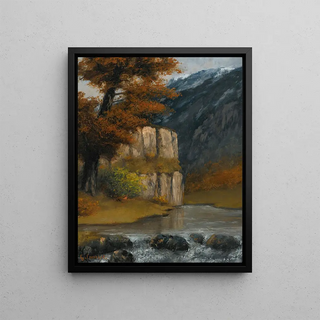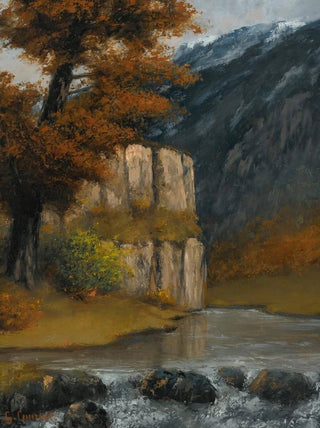Art print | Landscape near Ornans - Gustave Courbet


View from behind

Frame (optional)
In the enchanting landscape of Franche-Comté, Gustave Courbet captured the very essence of nature with his iconic work, "Landscape near Ornans." This canvas, painted in 1850, stands as a poignant testament to rustic beauty and the delicate nuances of the natural world. Through this piece, Courbet does not merely depict a simple landscape; he evokes an atmosphere, an emotion, and a profound connection with the land that saw him grow. The art print Landscape near Ornans - Gustave Courbet allows for an appreciation of the richness of this work, while offering an entry point into the captivating universe of the painter.
Style and uniqueness of the work
Courbet's style is distinguished by his realistic approach, which breaks away from the idealized conventions of his time. In "Landscape near Ornans," he chooses to depict a familiar scene, but with an intensity and realism that transcend mere representation. The earthy colors and rich textures reveal meticulous attention to detail, from majestic trees to reflections in the water. Every element of the painting seems to breathe, inviting the viewer to immerse themselves in this bucolic scene. Light plays a central role, creating interplay of shadow and illumination that brings the canvas to life. Courbet, as a pioneer of realism, was able to capture not only beauty but also the authenticity of his environment, placing the observer face-to-face with a vibrant, living nature.
The artist and his influence
Gustave Courbet, an emblematic figure of the realist movement, profoundly marked art history with his bold vision and commitment to faithful representation of reality. Born in 1819, he challenged the academic norms of his time, advocating for a painting that reflects everyday life and landscapes from his childhood. His influence extends well beyond his era, inspiring generations of artists to explore similar themes. With "Landscape near Ornans," Courbet does not limit himself to a simple depiction but engages in a dialogue about nature, identity, and the connection between man and his

Matte finish

View from behind

Frame (optional)
In the enchanting landscape of Franche-Comté, Gustave Courbet captured the very essence of nature with his iconic work, "Landscape near Ornans." This canvas, painted in 1850, stands as a poignant testament to rustic beauty and the delicate nuances of the natural world. Through this piece, Courbet does not merely depict a simple landscape; he evokes an atmosphere, an emotion, and a profound connection with the land that saw him grow. The art print Landscape near Ornans - Gustave Courbet allows for an appreciation of the richness of this work, while offering an entry point into the captivating universe of the painter.
Style and uniqueness of the work
Courbet's style is distinguished by his realistic approach, which breaks away from the idealized conventions of his time. In "Landscape near Ornans," he chooses to depict a familiar scene, but with an intensity and realism that transcend mere representation. The earthy colors and rich textures reveal meticulous attention to detail, from majestic trees to reflections in the water. Every element of the painting seems to breathe, inviting the viewer to immerse themselves in this bucolic scene. Light plays a central role, creating interplay of shadow and illumination that brings the canvas to life. Courbet, as a pioneer of realism, was able to capture not only beauty but also the authenticity of his environment, placing the observer face-to-face with a vibrant, living nature.
The artist and his influence
Gustave Courbet, an emblematic figure of the realist movement, profoundly marked art history with his bold vision and commitment to faithful representation of reality. Born in 1819, he challenged the academic norms of his time, advocating for a painting that reflects everyday life and landscapes from his childhood. His influence extends well beyond his era, inspiring generations of artists to explore similar themes. With "Landscape near Ornans," Courbet does not limit himself to a simple depiction but engages in a dialogue about nature, identity, and the connection between man and his






